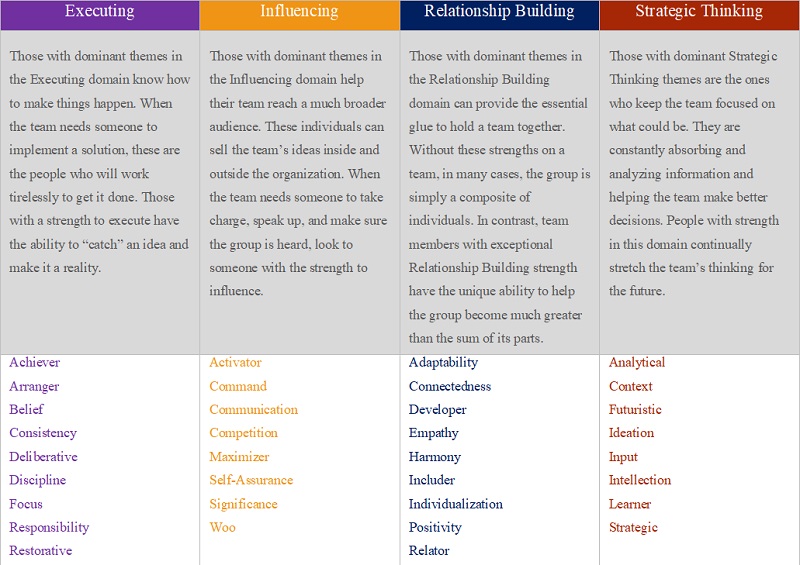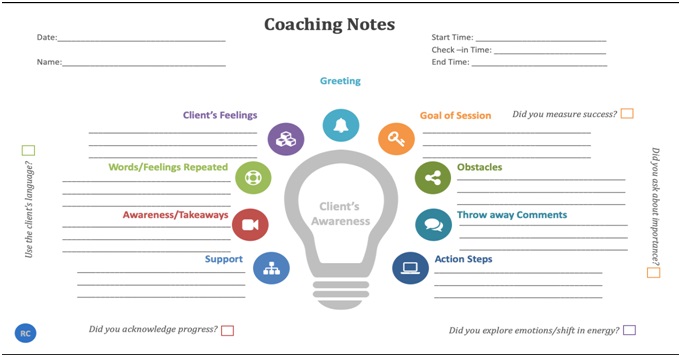
Research Paper By Rakael Carr
(Leadership/Financial Coach, UNITED STATES)
Introduction
As a leader who manages other leaders on a daily basis, I was intrigued by the Gallup StrengthsFinder 2.0 (GSF). When I discovered there was a tool that focused on strengths, not weaknesses I was delighted to give it a try. I have taken many assessments and this one proved to be extremely beneficial. It helped me recognize my talents and opportunities to maximize them as well as tools to strengthen my weaknesses. I also used the tool with my team to determine where our strengths were as a whole and what areas we were lacking that could pose a potential risk for us.
In the workforce, there is a constant need for leaders to improve themselves as they are the first in line for many of the organizational and developmental changes. Accurate data is essential when making decisions. Without accurate data, a tremendous amount of time could be exhausted on areas with very little benefit. Focusing on a large array of weakness that may only marginally improve is not as effective as focusing on the weakness where the client could gain maximum benefit. Only the client will know which areas to focus on that would best serve them in their role.
GSF allows the leader to develop self-awareness concerning their broad spectrum of talents. The GSF tool very rarely uses the term “weakness”; instead, it uses “dominant themes” and “lesser dominant themes.” The verbiage alone is inviting. As leaders, we are constantly focusing on what needs to be fixed or enhanced. Having a tool that says we are doing something right is phenomenal.
I believe the GSF assessment gives us permission to be kind to ourselves by using encouraging language in the individualized analytics report. Thirty-four themes is a lot of information to tackle and requires the user to develop a strategy, which can be accomplished in coaching. Coaching will give the client clarity and the opportunity to master their strengths, therefore propelling them into a realm of excellence within their field.
Self-awareness also provides the leader with opportunities to manage their weaknesses. Managing weaknesses in leadership are critical to success because if left unchecked, it could lead to potential risks for the organization or for the leader. Taking accountability, committing to improvement, and seeking support, could help drive and sustain commitment toward consistently enhancing their weaknesses.
Are you really leading, or are you just taking a walk?- John Maxwell
To be an effective leader you must have a tribe. Using GSF could help identify the best industry, role, and types of individuals that would be the best fit. Having a strategy for success is helpful in attaining success. Coaching clients around moving their strengths to mastery, managing their weakness, and finding the right fit for their organization, would be supported with the use of GSF and coaching.
What is GSF?
The Clifton StrengthsFinder is an assessment tool that consists of 180 paired comparison items that are classified into 34 groupings called “themes” which are divided into four domains. The assessments are time-based and the user cannot stay on any one question for an extended period of time. If too many questions expire before the questions are answered the assessment will time out. Upon completion, the user is presented with the top five themes of their talent ranked by dominance along with the ranking of the remainder themes (Larry Braskamp, StrengthsQuest Guide Book).

CliftonStrengths® Domains & Themes: Four Domains: Executing, Influencing, Relationship Building, Strategic Thinking
The Clifton StrengthsFinder is based on six principles of human nature and behaviour (Chip Anderson, 2004). They are:
Potential Weakness of GSF?
Nevertheless, GSF has its critics. There are those who believe the GSF tool is a nice idea but is essentially flawed. One of the alleged weaknesses according to Chamorro-Premuzic, 2016, is that the GSF assessment lacks scientific evidence of its effectiveness. However, according to Clifton Strengths Finder Technical Report 2.0, researchers both inside and outside Gallup contributed a number of investigations into its continuing reliability, validity, and applicability.
Another observation by critics of the assessment states that strengths do not equate to competence in a particular area. It is important to note that the GSF assessment helps individuals assess their individual strengths against themselves and not a benchmark. Critics believe the lack of benchmark data will give an individual a false sense of competence in the area they rank the highest. It should be noted, having competence in an area and having a personal strength in an area are separate values. Competence requires benchmark data. Personal strengths are unique to the individual.
Most of the themes are behavioural, which are subjective in nature; therefore evaluating competence in a particular area would require an industry standard. Most industry standards can be found within the industry. The leader could assess the standard that is required or any of their particular strengths. In addition, there was an additional concern that overused strengths become toxic in the workplace (Chamorro-Premuzic, 2016).
Leadership coaching with GSF would help leaders to gain awareness around any toxic behaviours. For example, the command is defined as being able to take control of a situation and make decisions. A general blind spot for people with the commanding theme as talent is intimidation. Allowing the client to have a safe place to explore the blind spots of their talents will give them a chance to focus and gain mastery. GSF will give them tips to manage their talent and leadership coaching could help move them to mastery and avoid toxicity. That will help improve their effectiveness as a leader.
Focusing on what is right
Self -Awareness of Strengths
What would happen if we studied what is right with people? (Lopez, Hodges, & Harter, 2005, p. 3).
Leaders are usually in the business of fixing things with hypersensitivity towards what needs improvement. By contrast, strengths-based leadership coaching creates awareness of an individual’s strengths. Information is key to any leader. Knowing what to focus on and where to focus allows the leader to optimize their time and efforts. Self-awareness of their strengths allows them to enhance their strengths and match their leadership style with the right role where their skills would be best utilized.
Strengthen Strengths Towards Mastery
To obtain mastery in any area one must be deliberate. Coaching around mastery of a particular strength would require the client to establish SMART goals around the specified talent. SMART goals are defined as: specific, measurable, attainable, relevant and time-based.
Let’s say the talent was communication, communication, in general, could be defined into 5 distinct types. The five types of communication are verbal, non-verbal/interpersonal, written, formal/informal, and visual, according to Hitesh Bhasin, 2019. Since the GSF only assesses an individual’s talent based on themselves and not benchmark, the leader would have to define which area of communication they feel is their strongest and work towards mastery in all areas of that talent. Coaching towards mastery will take time, commitment, accountability, and a high level of motivation.
Breaking down each talent allows the client to determine what they need to focus on to gain mastery and what areas will impact their role as a leader. It will also help them decide what mastery means to them. If the client scores high in communication but realizes through coaching they are at their best with face-to-face communication and they have a remote workforce, suddenly that may be an area they will need to explore deeper. Breaking down the talents also gives the leader a greater awareness of themselves. Striving for mastery in a particular talent will avoid the toxicity of overused strengths. Overused strengths are a concern when the client has not had the opportunity to explore potential blind spots of a talent.
All talents are GSFare accompanied with testimonial videos that describe the characteristics of that theme. It also comes with a strategy if the theme is dominant or lesser in the client. The client could bring the strategy to the coaching session to begin working on how to best accomplish mastery or if it is a lesser talent on how to manage the talent.
Manage Weakness
Manage Potential Risky Behaviors
GSF analytics and reporting suggest that leaders should claim their weaknesses, collaborate with others for support, apply their strengths, and commit to doing their best. Gaining self-awareness of less dominant traits could help avoid potentially risky situations. Generally, leaders are responsible for people and process. Overused strengths and ignored weaknesses could lead to potential harm to the organization or to the staff. It is essential for leaders to be aware of how their dominant and lesser dominant traits are impacting the organization and their staff.
Change is difficult for most and tackling areas that could have potential risk will help the leader move them out of the danger zone into a manageable zone. Managing risky behaviours could be accomplished in a couple of ways. It can be achieved by reducing the risk or managing the weakness. A leader could reduce the risk by changing the work environment.
If the leader is working in an environment that requires a high level of empathy and the leader has very little empathy but high analytical skills the leader might want to find a work environment that aligns with their skills.
If the leader chooses to manage the risk by improving themselves in that lesser talent area, coaching would be beneficial in outlining the client’s desired goals. Setting SMART goals around the desired outcome will help the client stay focused and motivated. Setting small goals with big wins could also help keep the client motivated.
Maintain Motivation While Managing Weaknesses
When there are areas that are not natural talents to the point of a potential risk, commitment to continuous improvement is necessary. This is where the coaching agreement is paramount. Understanding why it is important to the client will help the client stay focused and committed to the work. Also understanding the “who” of the client could help unlock any barriers the client may have that could be holding them back in that particular talent area.
To maintain momentum the client will need to have a high level of accountability and support to stay focused on improving weaknesses. Helping the client focus on systems or structures to support themselves in managing their weaknesses could also help ensure success.
Talent Match
With thirty-four themes and four domains an individual will have a good visual road map to determine what roles best suit their leadership style. Exploring the client’s dominant domains in search of the right role and type of staff they desire could prove highly beneficial to the client. Different styles of leadership strengths attract different types of followers.
The four domains are executing, influencing, relationship building, and strategic thinking. The executing domain helps individuals make things happen. The influencing domain helps individuals take charge, speak up and make sure others are heard. The relationship-building helps individuals help build strong relationships that hold teams together. Lastly, the strategic thinking domain helps individuals absorb and analyze information that informs better decisions (Gallup, 2016).
If a client is dominant in relationship building but works in an environment with little engagement, the client may want to consider opportunities that allow them to operate in their strengths. They may or may not find the right opportunity in their current industry. Exploring other potential industries with different opportunities that align with their strengths may lead to greater fulfilment as a leader.
Conclusion
Applying GSF to leadership coaching will allow the leader a greater level of clarity around their strengths, weakness, and their best role for optimum effectiveness. The client can develop goals using personalized Gallup analytics. Gallup suggests that leaders tackle the top five talents and then move to the next five for maximum effectiveness in enhancing the client’s strengths. When using GSF in leadership coaching the client may want to focus on their weakness to avoid any potential risks to the population they serve.
Coaching Application
The diagram I created below is a simple and effective guide to help navigate the coaching hour. It works by applying the ICF PCC markers and will add increased value when coaching leaders around their GSF results.
- Establish the coaching agreement around the assessment results.
- Set the goal of the session
- Determine what is important to the client to ensure commitment.
- Help the client visualize what success would look like in the area they seek to focus.
- Focus on powerful questions and direct communication
- Create Action steps around the goal
- Discuss accountability
- Celebrate the wins and support the client in their perceived failures.

Use the below diagram to navigate the coaching session:

References
Anderson, Edward C. (2004). StrengthsQuest: Curriculum Outline and Learning Activities. Princeton, NJ: Gallup Organization
Asplund, J., Agrawal, S., Hodges, J & Harter, J.Lopez, S. J (2014). Clifton StrengthsFinder 2.0 technical report: Development and validation. Princeton, NJ: The Gallup Organization.
Bhasin, H. (2019). Five Types of Communication: October 19, 2019 Marketing91
Chamorro-Premuzic, Tomas. (2016). Strengths-Based Coaching Can Actually Weaken You. Harvard Business Review
Lopez, S. J., Hodges, T., & Harter, J. (2005, p. 3). Clifton StrengthsFinder technical report: Development and validation. Princeton, NJ: The Gallup Organization.